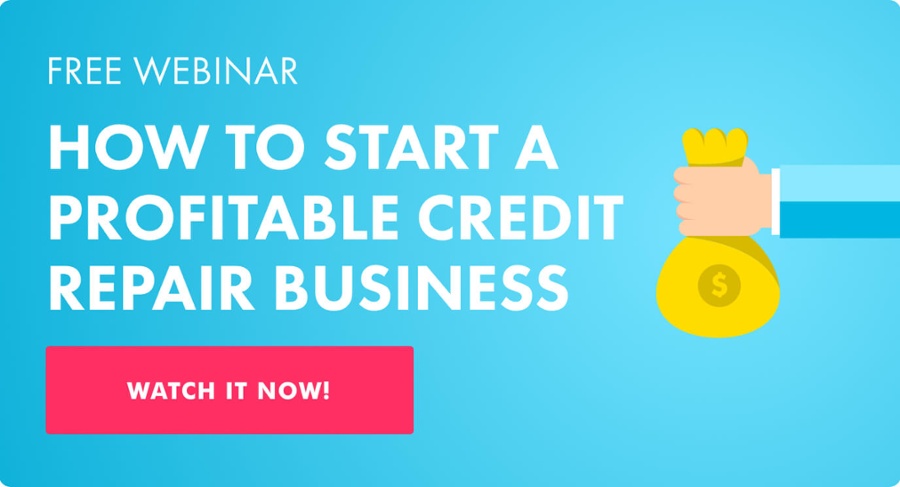51dd.jpg)
Learning best practices when it comes to maintaining or growing a credit score takes continued education and strategy, and not everyone has the dedication to do it on their own. For this reason, myths about credit continue to perpetuate.
Let’s quash these falsities for good.
The following are eight common credit myths every credit repair business can bust in order to help your community and bolster your reputation as an expert.
Myth #1: Credit Scores Only Take Credit Card Usage Into Account
Lenders use credit scores to assess the risk (or trustworthiness) of borrowers. As such, they need a comprehensive view into a borrower’s entire credit history, which reaches farther than just credit cards.
Here are two specific components of a credit score that take the entire borrowing history into account:
Credit mix
This makes up 10% of your FICO credit score. Though the category is a bit vague, the gist is that lenders want to know that anyone borrowing from them can handle a variety of debt, responsibly.
On-time payments
Payment history makes up the majority of a credit score at 35 percent Lenders want to see that consumers are able to make payments for any account they’re borrowing on to lower the lender’s risk. Payment history includes payments on items like:
- Student loans
- Car payments
- Credit cards
- Mortgages
How a consumer pays their debt, regardless of what type, will have an impact on their overall credit score.
Myth #2: Credit Length Is Not Important
Both FICO and Vantage credit scores take the length of credit history into consideration when calculating a score.
The FICO model uses the length of history to determine 15 percent of the entire score.
- How long credit accounts have been open
- The age of the oldest account
- The age of the newest account
- The average age of all accounts
- How long it has been since individual accounts have been used
The Vantage score clumps age and type of credit into the depth of credit bucket, which accounts for 9 percent of a credit score.
The good news is that even if a consumer hasn’t had established credit for a considerable length of time they can still have a good credit score. The rest of their profile just needs to be in order.
Myth #3: Checking Your Credit Score Will Hurt You
According to TransUnion’s July 2017 credit literacy survey, nearly 50% of respondents thought that any time a credit score is pulled, it will have a negative impact on your overall credit score.
Let’s set the record straight. There are two different ways to check a credit score. One way is called a hard inquiry and the other is a soft inquiry.
Hard inquiries
Occurs when someone is trying to borrow money. It’s how a lender can assess their creditworthiness. This type of pull can have an impact on a credit score, but it’s not from checking your own credit.
Additionally, if a consumer is rate shopping, most credit bureaus cluster hard inquiries that occur within a designated period of time together to limit the number of hits on a credit report:
- FICO scores calculated from older versions of the scoring formula have a 14-day window
- FICO scores calculated from the newest versions of the scoring formula have a 45-day window
- The VantageScore model has a 14-day window
Soft inquiries
Soft inquiries are when a consumer wants to check their own credit without applying for financing. Consumers and credit repair specialists can access this type of credit pull using special programs, like IdentityIQ, which will give an estimate of a credit score, without affecting it.
Myth #4: Closing Old Accounts is a Good Thing
In the aforementioned TransUnion survey, approximately 35% of survey participants indicated that they believed closing a credit card account decreases a credit score, and another 20% say they have no idea what effect closing an account has on their credit score.
While it’s always best to pay off debt to avoid revolving balances, closing accounts should be done thoughtfully.
Sometimes closing accounts won’t have a meaningful impact on a credit score, like if it:
- Is a credit card with a small limit
- Has only been open for a short period of time
- Has no penalty associated with closing it (like if it’s been paid off early)
However, sometimes closing accounts can have a larger impact like if it has:
- The longest history of all open accounts
- One of the largest limits in an overall credit profile
While it sounds counterintuitive to leave credit cards or other credit accounts open when they aren’t in use, it can sometimes act as padding for an account by increasing the credit history length or decreasing the overall utilization ratio.
When in doubt, consumers should ask a credit repair company for guidance before closing accounts.
Myth #5: All Debts Are Equal
5a79.jpg)
When creating a plan to pay off debt, it’s not a game of pin the tail on the donkey where someone blindly takes a stab at reducing debt. When approaching a debt schedule, there is a rhyme and reason behind which debts to reduce first, because not all debt is created equal.
Some debts are considered “better” than others at face value. For instance:
- Mortgage debt can be seen as positive debt (or an investment) under the assumption a home’s value will grow over time
- Student loan debt is seen as good debt because it may eventually land the borrower a high-paying position
Having good debt is obviously better than having bad debt, so weighing the good vs. the bad should play a role in the debt reduction strategy.
On the flip side, some types of debt will cost more than others because of their high interest rates, like:
- Credit cards
- Car payments
Bad debt is usually associated with revolving debt, which is credit that remains the same amount month over month (think of a credit card limit) and can amass high interest charges, if not paid off entirely each month.
Bad debt may also include purchases that lose value quickly (like an automobile). These debts are also expensive to pay off once they start accruing interest. For that reason, it’s usually wise to tackle bad debt first.
Myth #6: There is Only One Credit Score
While many of us may know there are three credit bureaus (Experian, Equifax, and TransUnion) we might not be familiar with how each bureau calculates your credit score.
You might be surprised to know that there isn’t just one method for calculating credit scores amongst the three bureaus. In fact, there are many scoring models used, and as predictive modeling and risk assessment technology gets more sophisticated, techniques are evolving every day.
In a nutshell, credit scores are different from each bureau because they all collect different data, and their methodology for risk assessment might vary.
The three large bureaus score credit by the following ranges:
- Experian: 330 – 830
- Equifax: 300 – 850
- TransUnion: 300 – 850
Additionally, these two scoring methods are also common in the credit world:
- FICO: 300 – 850
- VantageScore: 501 – 990 (often assigned a letter grade, A – F)
A consumer could technically have dozens or even hundreds of credit scores. Regardless, they should all be an accurate assessment of how healthy one’s credit profile is.
Myth #7: You and Your Significant Other Share a Credit Score
When two people marry, combining bank accounts or opening credit cards together is often a natural progression. But, just because they’re joining finances, doesn’t mean they’re joining credit scores.
When both parties contribute to major purchases, like signing for a mortgage together, both are impacted by the credit decision but it is reflected on each individual credit report differently.
That’s right, there is no such thing as a joint credit report.
A credit score is a lot like a social security number, it follows an individual regardless of name changes, and partnership changes. Each person is solely responsible for how their credit report looks, and solely responsible for seeking help should the responsibility get too great.
That means if your credit score needs improvement, it’s up to you to reach out to a credit professional to get you back on track.
Myth #8: Errors on Credit Reports Are Easy to Remove
Getting errors removed from a credit score can be a time-consuming process, which is why many consumers seek the help of a credit repair business or specialist.
For example:
- The first step to removing an error is for you or a credit repair specialist to write a dispute letter to the credit bureaus pointing out the account in question, and asking if they can verify the charges.
- The results: If they can’t verify the account, the errors will be removed in time. If they can verify the charges, it doesn’t mean a client is out of luck, it simply means the process will take more time to rectify.
- The second step requires credit repair specialist to submit a second dispute letter asking the credit bureaus or creditors how they can verify the account.
- The results: If the credit bureaus or creditors can’t verify the account, they must remove the debt, which a specialist will need to continue to follow up on. Additionally, if they don’t respond accurately, a credit repair specialist may need to write another letter.
The process can continue like this for three or four (or more) letters. The entire process is bound to take months and in rare instances years.
That’s why it’s important to know that when someone embarks on a credit repair journey, patience is a virtue, and seeking help from a professional can help ease the burden of the process and yield results faster.
Bottom Line
There are many intricacies when it comes to credit, and by becoming an expert in the trade, you can reap rewards others can’t. Credit repair specialists have the opportunity to start their own business while simultaneously helping consumers live a better life.
Ready to become a credit hero? Join our live web training today for even more valuable credit knowledge.













